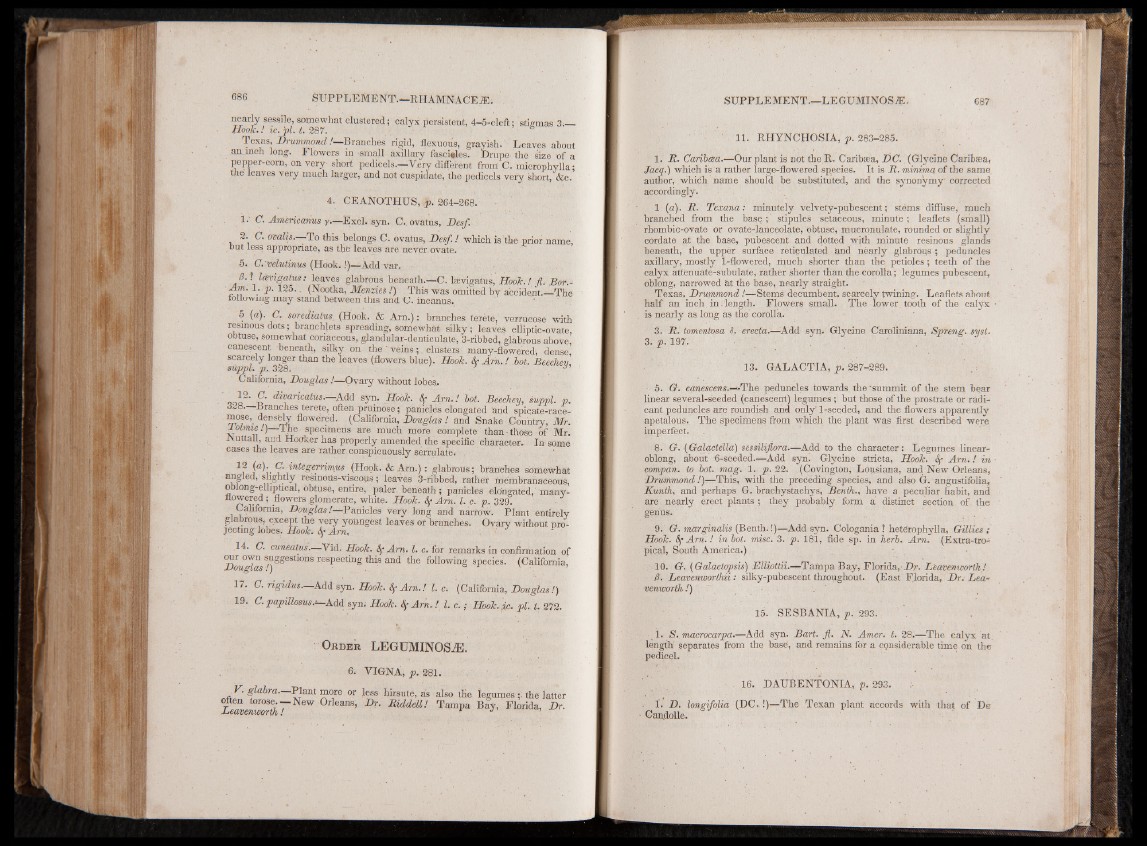
nearly sessile, somewhat clustered; calyx persistent, 4-5-cleft; stigmas 3—
Hook-! ic.pl. t. 287. . .-
Texas, Drummond !—Branches rigid, flexuous, grayish. Leaves about
an inch long. Flowers in small axillary fascicles. Drupe-the size of a
pepper-corn, on very- short pedicels.—Very different from C, microphylla;
the leaves very much larger, and not cuspidate, the pedicels very short, &e.
4. CEANOTHUS, p. 264-268.
1. ' C. Americanus y.—Excl. syn. C.. ovatus, Desf.
2. C. ovalis. To this belongs C. ovatus, Desf.! which is the prior name,
but less appropriate, as the leaves are never, ovate.
5. C. velutinus (Hook.!)—Add var.
0.1 Icevigatus: leaves glabrous beneath.—C. lasvigatus, Hook.ljl. Bor.-
Am. 1 • p. 125.. (Nootka, Menzies !) This was omitted by accident.—The
iollowmg may stand between this and C. ineanus.
5 (a). C. sorediatus. (Hook. & Arn.): branches terete, verrucose with
resinous dots; branchlets spreading, somewhat silky; leaves elliptic-ovate,
obtuse, somewhat coriaceous, glandular-denticulate, 3-ribbed,. glabrous above,
canescent beneath, silky on the ' veins ;. clusters many-flowered; dense,
scarcely longer than the leaves (flowers blue). Hook. Sr A m .! hot. Beechev
SfOqmk p, 328, , \ ^
California, Douglas !—Ovary without lobes,
ooq2' dil aricatus-—Ad(l syn. Hook. Sf Arn.! lot. Beechey, suppl. p.
328— Branches terete, ofteh pruinose; panicles elongated and spiqaie-race-
mose, densely flowered. (California, Douglas ! and Snake .Country, Mr.
2 olmie /)—-The specimens are much more complete than • those of Mr.
iN uttall, and Hooker has properly amended the specific character. In some
cases the leaves are rather conspicuously serrulate.- , ’
12 (a). C.-integerrimus (Hook. & Arn.): glabrous; branches somewhat
m 6d’ 7,lg - y rcsin°bs-viscous; leaves 3-ribbed, rather Membranaceous,
oblong-elliptical, obtuse, entire, paler, beneath; panicles elongated, ■many-
flowered ; flowers glomerate, white. Hook. Sf Arn. 1. c .p . 329.
California, Douglas!—Panicles very long and narrow1. Plant entirely
glabrous, except the very youngest leaves or branches. Ovary without projecting
lobes. Hook. Sf Am, . “
.14. C. cuneatus.—Vid. Hook. If Arn. 1. c. for remarks in confirmation of
- ^ s u g g e s t i o n s respecting this and the following species. (California,'
17. C. rigidus.—Add syn. Hook. 8fArn.! 1. c. (California, Douglas!)
19. C. papillosus.-—Add syn; Hook. Sf Am. ! 1. c .; Hook. ic. pi. t. 272.
Or d e r LEGUMINOSiE.
6. V IGNA, p . 281.
V. glabra. Plant more or less hirsute, as also the legumes;. the latter fZSSTtkm 0rl,s“’ ■f'mdd,U! T »v-
11. RHYNCHOSIA, p. 283-285.
1. R. Caribma.—Our plant is not the.R. Caribsea, DC. (Glycine Caribfea,
Jacq.) which is a rather large-flowered species. It is R. minima of the same
author, which name should be substituted, and the synonymy corrected
accordingly.
1 (a). R. Texana: minutely velvety-pubescent; stems diffuse, much
branched from the base; stipules setaceous, minute; leaflets (small)
rhombic-ovate or ovate-lanceolate, obtuse, mucronulate, rounded or slightly
cordate at the base, pubescent and dotted with minute resinous glands
beneath, the upper surface. reticulated and nearly glabrous ; peduncles
axillary, mostly 1-flowered, much shorter than the petioles ; teeth of the
calyx attenuate-subulate, rather shorter than the corolla; legumes pubescent,
oblong, narrowed at the base, nearly straight.
Texas, Drummond !—Stems decumbent, scarcely twining. Leaflets about
half an inch in;length. Flowers small. The lower, tooth of the calyx
is nearly as. long as the corolla.
3. R. tomentosa S. erecta.-—Add syn. Glycine Caroliniana, Spreng. syst.
3. p. 197.
13. GALACTIA, p. 287-289.
5. G. caneseens.^-The peduncles towards the "summit of the stem bear
linear several-seeded (canescent) legumes; but those of the prostrate or radi-
cant peduncles are roundish and only 1-seeded, and the flowers apparently
apetalous. The specimens from which the' plant was first described were
imperfect.
8. G. (Galactella) sessiliflora.—Add to the character: Legumes linear-
oblong, about 6-seeded.—Add synl Glycine stricta, Hook. &f A rn .! in
compan. to hot. mag. 1. p. 22. (Covington, Lousiana, and New Orleans,
Drummond!)—This, with the preceding species, and also G. angustifolia,
Kunth, and perhaps G. brachystachys, Benth., have a peculiar habit, and
are nearly erect plants ; they probably form a distinct section of the
genus.
9. G. marginalis (Benth.!)—Add syn. Cologania ? heterophylla, Gillies ;
Hook. Sf A m .! in lot. misc. 3. p. 181, fide sp. in herb. Arn. (Extra-tropical,
South America.) . ■
10. G. (Galactopsis) Elliottii.—Tampa Bay, Florida, Dr. Leavenworth!
0. Leavenuiorthii: silky-pubescent throughout. (East Florida, Dr. Leavenworth
!)
15. SESBANIA, p. 293. .
1. S. macrocarpa.—Add syn. Bart. fl,. N. Amer. t. 28.—The calyx at.
length separates from the base, and remains for a considerable time on the
pedicel.
16. DAUBENTONIA, p. 293. :•
i . D. longifolia (DC. !)—The Texan plant accords with that of Do
Candolle.